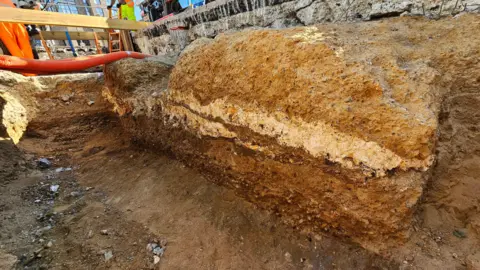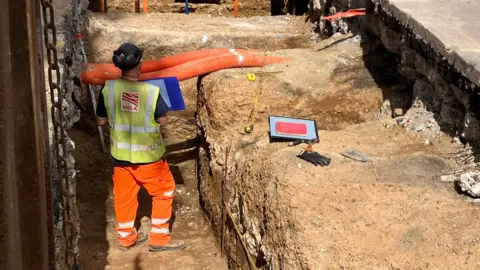Roman road revealed directly under Old Kent Road
 Museum of London Archaeology
Museum of London ArchaeologyA section of one of Britain’s most important Roman roads has been unearthed under Old Kent Road in south-east London.
Known as Watling Street, the near 2,000-year-old road ran from the Roman port at Dover through London to the West Midlands.
Archaeological work has been taking place as part of the expansion of Southwark’s heating network by the local council and utilities company Veolia.
Southwark Council said its discovery provides the first physical proof that sections of the ancient route survive directly beneath its modern counterpart.
 Southwark Council/Veolia
Southwark Council/VeoliaThe road was identified by a team of archaeologists from the Museum of London Archaeology (MOLA), with advice and support from the council’s in-house archaeology officer Dr Chris Constable.
Built shortly after the Roman invasion of Britain in AD 43, archaeologists were able to roughly locate the old Watling Street due to the straight nature of many Roman roads but there was scant archaeological evidence of this.
The section of road revealed lies to the south of the junction of Old Kent Road and Ilderton Road and was well preserved, measuring about 19ft (5.8m) wide by almost 5ft (1.4m) high.
Southwark Council said distinct layers could be seen and showed a solid foundation of compacted gravel sealed by two layers of chalk, before it was topped with another layer of compacted sand and gravel.
 Museum of London Archaeology
Museum of London ArchaeologyIt added the original surface of the road would likely have been made from the same material and would have sat at a similar level to the modern road, but over time this had been lost.
Dr Constable said a section of the road to the south of the Cantium Retail Park was excavated in the early 1990s, but questions had remained over the exact course of the road until now.
"In the planning for this project, we’d expected to solve this question but the extent of survival of the road is remarkable," he explained.
"We hope this project will answer some other archaeological questions in the borough.”
The discovery means modern drivers are following the same route once used by visiting emperors, including Hadrian in AD 122, when he ordered the building of the famous wall, and later in the 14th Century as a route of pilgrimage to Canterbury.
A sign will now be put up on the nearby railway bridge to mark the findings.
Listen to the best of BBC Radio London on Sounds and follow BBC London on Facebook, X and Instagram. Send your story ideas to [email protected]
